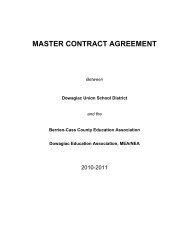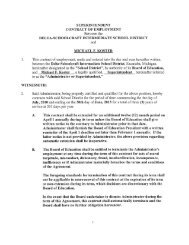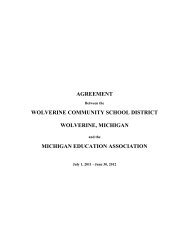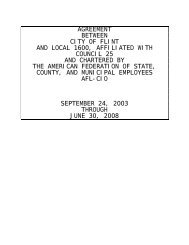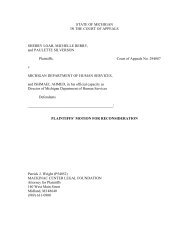The Cost of Remedial Education - Mackinac Center
The Cost of Remedial Education - Mackinac Center
The Cost of Remedial Education - Mackinac Center
Create successful ePaper yourself
Turn your PDF publications into a flip-book with our unique Google optimized e-Paper software.
<strong>The</strong> <strong>Cost</strong> <strong>of</strong> <strong>Remedial</strong> <strong>Education</strong>:<br />
How Much Michigan Pays When Students Fail to Learn Basic Skills<br />
<strong>Mackinac</strong> <strong>Center</strong> for Public Policy<br />
worsens this rate (and there is strong reason to believe that the situation should worsen as<br />
students get older), we can estimate that a third <strong>of</strong> Michigan students leave public school<br />
lacking basic skills.<br />
Interestingly, this rather rough way <strong>of</strong> estimating the number <strong>of</strong> students lacking<br />
basic skills generates a figure surprisingly close to the number in our prior estimate. If a<br />
third <strong>of</strong> students who enter high school in Michigan leave lacking basic skills, the figure<br />
would be around 39,900. According to our prior estimate that 29,085 students drop out and<br />
14,848 students enroll in remedial education, a total <strong>of</strong> 43,900 students leave high school<br />
each year lacking basic skills. Only 4,000 students separate the two figures.<br />
If we assume that these 39,900 students are roughly two years behind in their skills<br />
and if the cost <strong>of</strong> handling their lack <strong>of</strong> skills is roughly equal to the cost <strong>of</strong> teaching those<br />
skills in high school, then the lack <strong>of</strong> basic skills costs Michigan employers and schools <strong>of</strong><br />
higher education approximately $523 million per year. Using the last three strategies we are<br />
arriving at annual figures close to a half-billion dollars.<br />
Strategy 5: Including a “Return on Investment”<br />
<strong>The</strong> costs <strong>of</strong><br />
incarceration,<br />
welfare, and<br />
unemployment are<br />
quite high<br />
compared to the<br />
cost <strong>of</strong> education.<br />
<strong>The</strong> last three estimates make a conservative assumption: that the “return on the<br />
investment” <strong>of</strong> teaching students basic skills is “a wash.” That is, we are assuming that<br />
spending roughly $13,000 to remediate a student who is two years behind on learning basic<br />
skills (Strategy 3’s annual “per successful graduate cost” <strong>of</strong> $6,553 times two years <strong>of</strong><br />
remediation) will save only $13,000 later in that student’s life. <strong>The</strong> return is likely to be<br />
much greater. If possessing basic skills increases a worker’s productivity, that $13,000 could<br />
easily yield many times the original investment, especially when one considers that the<br />
increase in productivity occurs over the worker’s entire working life. Conversely, failing to<br />
remediate a student or worker for $13,000 may ultimately cost society many times more<br />
money. <strong>The</strong> costs <strong>of</strong> incarceration, welfare, and unemployment are quite high compared to<br />
the cost <strong>of</strong> education.<br />
If we change the cost estimate used in Strategy 3 so that the return on remedial<br />
education expenditures is a modest 3-percent real return over a 30-year period, the cost<br />
balloons to $1.15 billion. <strong>The</strong> calculation is as follows: $89 million (the direct expenditures<br />
by higher education) + [$6,552.66 (the cost per pupil per year <strong>of</strong> producing a successful<br />
graduate) multiplied by 29,085 (the number <strong>of</strong> dropouts) multiplied by 2.29 (the number <strong>of</strong><br />
years they are missing on average from high school, which is an indicator <strong>of</strong> how far behind<br />
they are) multiplied by 1.03^30 (which is how much a dollar is worth after thirty years<br />
compounded at 3%)] = $1.15 billion.<br />
Even this large number, however, may well be too low an estimate <strong>of</strong> the cost <strong>of</strong> the<br />
lack <strong>of</strong> basic skills. A 3-percent real return may be too low. (<strong>The</strong> real return on 30-year<br />
Treasury bonds is closer to 4 percent, while the real return on investments in the stock<br />
accessed on August 18, 2000. <strong>The</strong> 8 th -grade is the oldest group for which scores are available in<br />
Michigan. “Below basic” is defined by NAEP as a level <strong>of</strong> pr<strong>of</strong>iciency below the “basic” level,<br />
which “denotes partial mastery <strong>of</strong> prerequisite knowledge and skills that are fundamental for<br />
pr<strong>of</strong>icient work at that grade.”<br />
September 2000 15




